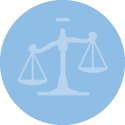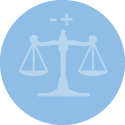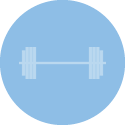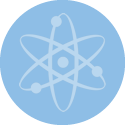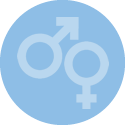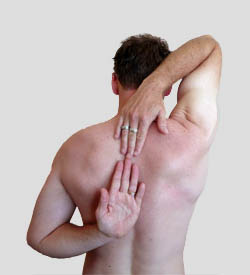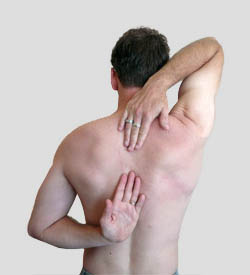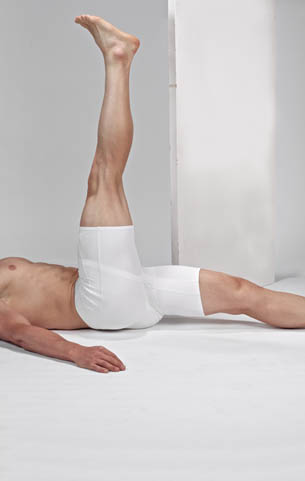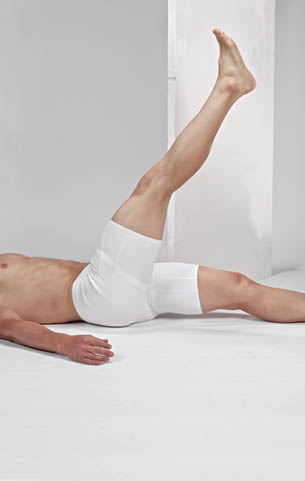Done and done.
Rad.
We're going to give you the best exercise plan with the optimal time.
Sign up! Get your plan. Roundhouse kick some faces.
Low
EffectivenessHigh
EfficiencyLow
Efficiency
![]() Let's shed some pounds! The challenges with losing fat are, generally speaking, maintaining a caloric deficit, preventing metabolic slow-down, and doing it without cannibalizing lean tissues (i.e. avoiding rampant muscle loss). To that end your training plan...
Let's shed some pounds! The challenges with losing fat are, generally speaking, maintaining a caloric deficit, preventing metabolic slow-down, and doing it without cannibalizing lean tissues (i.e. avoiding rampant muscle loss). To that end your training plan...
more will contain a balance of different cardiovascular training methods to help you 1) increase your caloric deficit and 2) improve metabolic activity - you may see intervals prescribed for the latter. At the same, you will train for strength and some hypertrophy in order prevent the catabolization of your muscle; a more metabolically active tissue to begin with.
less
![]() Muscle it is! While we're going to get you big, we'll also need to make you strong in order to lift heavier loads and apply more tension to the muscles. To that end you'll see a mixture of classic compound exercises performed in a hypertrophy range
...
Muscle it is! While we're going to get you big, we'll also need to make you strong in order to lift heavier loads and apply more tension to the muscles. To that end you'll see a mixture of classic compound exercises performed in a hypertrophy range
...
more
of 8-12 reps (a nice sweet spot in terms of load and time - though this will vary by exercise). We will limit your hampster work (oops, we meant to write 'traditional cardio') in order to prevent interference of adaptation. The minimal cardio you will see is there to maintain work capacity and improve rate of recovery.
less
![]() Ok, not gonna' lie - losing fat and gaining muscle at the same time is tricky. Generally speaking, the more experienced you are, unless you're coming off a break from training or have fallen out of shape, you shouldn't expect to simultaneously
...
Ok, not gonna' lie - losing fat and gaining muscle at the same time is tricky. Generally speaking, the more experienced you are, unless you're coming off a break from training or have fallen out of shape, you shouldn't expect to simultaneously
...
more
gain large quantities of muscle or lose large amounts of fat. That said, if you are new to it, or are coming off a break, then you should expect some good results. As far as how you'll train - you'll need a mix of hypertrophy, strength and cardiovascular methods. The hypertrophy work is self-explanatory and will be facilitated by also training for strength. The cardiovascular work will focus on improving metabolic activity and caloric partitioning (rather than on creating an energy deficit - as you might see in traditional weight loss plans).
less
![]() Excellent. Let’s get brutally strong. While muscle cross-sectional area certainly contributes to strength, neural efficiency and coordination are critically important. In order to get extremely strong you need to recruit as many of your motor units as possible, synchronize their contractions and coordinate these activities between and across all agonists, antagonists and stabilizers in the key movements (e.g. squatting, pulling and pushing).
Excellent. Let’s get brutally strong. While muscle cross-sectional area certainly contributes to strength, neural efficiency and coordination are critically important. In order to get extremely strong you need to recruit as many of your motor units as possible, synchronize their contractions and coordinate these activities between and across all agonists, antagonists and stabilizers in the key movements (e.g. squatting, pulling and pushing).
![]() Sex imposes a unique but rarely discussed set of fitness demands - many of which are easily trained. For the orgasm opportunist, it's important to have excellent cardiovascular fitness, strong and mobile hips, core strength and body control, and of course specific strength and endurance in the muscles of the pelvic floor. To learn more, click here.
Sex imposes a unique but rarely discussed set of fitness demands - many of which are easily trained. For the orgasm opportunist, it's important to have excellent cardiovascular fitness, strong and mobile hips, core strength and body control, and of course specific strength and endurance in the muscles of the pelvic floor. To learn more, click here.
![]() Cardiovascular, resistance and coordination exercises have all been shown to have favorable impacts on cognitive health. To learn more, click here.
Cardiovascular, resistance and coordination exercises have all been shown to have favorable impacts on cognitive health. To learn more, click here.
![]() Baseball, generally speaking, demands short bouts of high power output. General training needs include strength and speed - while specific care and attention needs to be paid to the shoulder girdle. Hypertrophy will also be sought to the extent it facilitates strength and power.
Baseball, generally speaking, demands short bouts of high power output. General training needs include strength and speed - while specific care and attention needs to be paid to the shoulder girdle. Hypertrophy will also be sought to the extent it facilitates strength and power.
![]() Basketball imposes truly broad fitness requirements - demanding endurance, explosiveness, agility and strength. All of these qualities are important for your performance on the court, and all of these qualities will be trained. Even hypertrophy will be developed to some degree - not hypertrophy for hypertrophy's sake, but to facilitate strength and the ability to absorb contact and finish at the rim.
...
Basketball imposes truly broad fitness requirements - demanding endurance, explosiveness, agility and strength. All of these qualities are important for your performance on the court, and all of these qualities will be trained. Even hypertrophy will be developed to some degree - not hypertrophy for hypertrophy's sake, but to facilitate strength and the ability to absorb contact and finish at the rim.
...
more
While the need for endurance and explosiveness is obvious, the need for strength is not necessarily. However, strength will be foundational to your other athletic qualities, in particular speed and explosiveness. In the lower body this work will facilitate your vertical leap, while in the upper body strength and explosiveness - particularly in certain overhead positions as in a military press or pull-up - will also facilitate your rebounding skills (as well as a host of other passing, dribbling and positioning skills). Note that we will attempt to focus your training on the important basketball-oriented fitness qualities in which you are currently weakest.
less
![]() Strength, speed and size are the name of the game here. We need to get you big and brutally strong, but also fast. To that end you will train with heavy weights at high loads for strength, moderate weights at higher volume for hypertrophy, and ballistic movements to develop speed and translate your strength into winning on the field. Outside of maintaining a basic level of fitness and cardiovascular capacity, endurance will take a back seat and - if it does get trained - will be trained in intervals.
Strength, speed and size are the name of the game here. We need to get you big and brutally strong, but also fast. To that end you will train with heavy weights at high loads for strength, moderate weights at higher volume for hypertrophy, and ballistic movements to develop speed and translate your strength into winning on the field. Outside of maintaining a basic level of fitness and cardiovascular capacity, endurance will take a back seat and - if it does get trained - will be trained in intervals.
![]() Sorry folks - still working on our olympic lifting models. That said, your plan, when it's ready, will focus on strength, rate of force development, reactive ability, and functional hypertrophy.
Sorry folks - still working on our olympic lifting models. That said, your plan, when it's ready, will focus on strength, rate of force development, reactive ability, and functional hypertrophy.
![]() Sorry folks - still working on our running models. Let us know if you have any particular concerns or considerations with your running plan
...
Sorry folks - still working on our running models. Let us know if you have any particular concerns or considerations with your running plan
...
more
.
We'll also let you choose running distances soon (sprinting is a very very different animal from distance running!), but clearly Usain here is a fringe case
less
![]() Football requires a very high level of stamina, but also the ability to generate and maintain sustained bursts of glycolytic activity (e.g. repetitive sprints). Moreover, football demands both a high level of agility and lower body power. To this end you will see a variety
...
Football requires a very high level of stamina, but also the ability to generate and maintain sustained bursts of glycolytic activity (e.g. repetitive sprints). Moreover, football demands both a high level of agility and lower body power. To this end you will see a variety
...
more
of cardiovascular methods aimed at maintaining performance over 90 minutes, as well as lower body strength and speed work to get you to the ball first. Note that extra size, to the extent it does not create relative improvements in speed and power, is undesirable, and hypertrophy work will be moderated accordingly.
less
![]() Sorry about this but we're still working on our swimming here. Check back soon though and let's unleash the Michael Phelps in you.
Sorry about this but we're still working on our swimming here. Check back soon though and let's unleash the Michael Phelps in you.
![]() We view your health - to the extent that your exercise program can specifically impact it - across three primary dimensions. These are cardiovascular health, bone density and joint health, and cognitive/neuronal health. The former will, rather self-evidently, be trained
...
We view your health - to the extent that your exercise program can specifically impact it - across three primary dimensions. These are cardiovascular health, bone density and joint health, and cognitive/neuronal health. The former will, rather self-evidently, be trained
...
more
through various cardiovascular exercises. These in turn will be selected while attempting to find an appropriate load - a non-degenerative-load - for your joints. Bone density and joint health will be trained specifically through strength and hypertrophy methods, and - this may not be obvious - with exercises which improve your posture and thus the long term conformations and health of your joints. Finally, and the neuroscientists on our team are particularly stoked about this - different training methods have been shown to combat neurodegenerative diseases, increase neurogenesis, enhance mood and improve cognitive performance across a variety of tasks. We select an appropriate variety of exercises to take advantage of this.
less
![]() We view your health - to the extent that your exercise program can specifically impact it - across three primary dimensions. These are cardiovascular health, bone density and joint health, and cognitive/neuronal health. The former will, rather self-evidently, be trained
...
We view your health - to the extent that your exercise program can specifically impact it - across three primary dimensions. These are cardiovascular health, bone density and joint health, and cognitive/neuronal health. The former will, rather self-evidently, be trained
...
more
through various cardiovascular exercises. These in turn will be selected while attempting to find an appropriate load - a non-degenerative-load - for your joints. Bone density and joint health will be trained specifically through strength and hypertrophy methods, and - this may not be obvious - with exercises which improve your posture and thus the long term conformations and health of your joints. Finally, and the neuroscientists on our team are particularly stoked about this - different training methods have been shown to combat neurodegenerative diseases, increase neurogenesis, enhance mood and improve cognitive performance across a variety of tasks. We select an appropriate variety of exercises to take advantage of this.
less
![]() Let the cows come home... The Calves are composed of two primary muscles - the gastrocnemius and the soleus (while some anatomists prefer to group the two as the 'triceps surae' muscle, we will discuss the two separately). The gastrocnemius is primarily a fast twitch muscle responsible for rapid contractions, while the soleus
...
Let the cows come home... The Calves are composed of two primary muscles - the gastrocnemius and the soleus (while some anatomists prefer to group the two as the 'triceps surae' muscle, we will discuss the two separately). The gastrocnemius is primarily a fast twitch muscle responsible for rapid contractions, while the soleus
...
more
is predominantly a slow twitch tonic/postural muscle. The primary function of the muscles - and what you'll be training - is plantar flexion, basically the movement you perform when pressing on the gas pedal. You could say we're going to 'step on the gas' with your calf training... ok, sorry for that one. Note that the gastrocnemius muscle also contributes to flexion of the knee (the gastrocnemius crosses the knee joint - the soleus does not). While you may train some plantarflexion in isolation, note that the calves are still heavily loaded in compound exercises like squats and deadlifts.
We would also note that the hypertrophy potential of the calves, as well as explosive potential, are both influenced by the insertion point of the calf muscles and the length of the Achilles tendon. Longer Achilles tendons will store more elastic energy and provide a benefit with sprinting and jumping, while shorter tendons and longer muscle bellies can contribute to greater potential for muscle growth.
Note that Anterior Tibialis (shin) work will help prevent imbalances if you do choose to perform a high volume of work on the calves. Note also that the calves are not, as some people believe, the primary determinant of jumping performance - this is more a function of power at the knees and hips, neural efficiency (i.e. synchronization, rate coding etc.), and relative body strength. Finally, as many long-time bodybuilders and fitness enthusiasts have observed, the calves can be particularly difficult to enlarge in some populations. There is evidence that a lower density of androgen receptors (as compared, to say, the muscles of the upper body) in the calves may make hypertrophy more difficult in some individuals.
Note that we try to create balance across the muscles and joints of your body. By specializing - unless you focus on a known weakness - your training plan may become less efficient, and, over time, potentially lead to imbalances. That said, you command this ship, and we'll help you build any kind of body you want.
less
![]() Sir Mix a Lot loves you. The gluteal muscles are composed of gluteus maximus (the largest of the gluteal muscles and one of the largest muscles of the body), gluteus medius and gluteus minimus. The glutes perform a variety of movements around the hip - including, but not limited to, hip extension, abduction and medial and lateral rotation. As such
...
Sir Mix a Lot loves you. The gluteal muscles are composed of gluteus maximus (the largest of the gluteal muscles and one of the largest muscles of the body), gluteus medius and gluteus minimus. The glutes perform a variety of movements around the hip - including, but not limited to, hip extension, abduction and medial and lateral rotation. As such
...
more
, the glutes are pivotal for performance in most sports, and play a critical role in running and jumping. Traditional powerlifting movements, which demand hip extension under high tension - tend to be excellent for developing the glutes, although additional movements are necessary for complete development.
The shape and appearance of the butt is determined not only by the size and resting tone of the gluteal muscles, but also posture, fat deposits (too much can cause sagging, but equally, a moderate amount can improve appearance), and the size and development of the hamstrings.
Note that we try to create balance across the muscles and joints of your body. By specializing - unless you focus on a known weakness - your training plan may become less efficient, and, over time, potentially lead to imbalances. That said, you command this ship, and we'll help you build any kind of body you want.
less
![]() The Hamstrings are composed of three powerful muscles - semitendinosus, semimembranosus and the biceps femoris. They play a critical role in both hip extension and knee flexion and therefore, unsurprisingly, running and jumping. To target your hamstrings you will be training with exercises that target hip extension
...
The Hamstrings are composed of three powerful muscles - semitendinosus, semimembranosus and the biceps femoris. They play a critical role in both hip extension and knee flexion and therefore, unsurprisingly, running and jumping. To target your hamstrings you will be training with exercises that target hip extension
...
more
, exercises that target knee flexion and exercises which target both simultaneously.
Note that we try to create balance across the muscles and joints of your body. By specializing - unless you focus on a known weakness - your training plan may become less efficient, and, over time, potentially lead to imbalances. That said, you command this ship, and we'll help you build any kind of body you want.
less
![]() The quadriceps are composed of four large muscles or 'heads' which are responsible primarily for knee extension. These are the Rectus Femoris, Vastus Lateralis, Vastus Medialis and Vastus Intermedius. In Latin they mean 'Squat Heavy Weights.' Ok, not really, but that's part of what you'll be doing to develop them
...
The quadriceps are composed of four large muscles or 'heads' which are responsible primarily for knee extension. These are the Rectus Femoris, Vastus Lateralis, Vastus Medialis and Vastus Intermedius. In Latin they mean 'Squat Heavy Weights.' Ok, not really, but that's part of what you'll be doing to develop them
...
more
. Note that some traditional exercises like knee extensions impose excessive shear forces on the patella (the knee cap), and we will rarely prescribe them. On the other hand, some exercises help maintain and improve stability in the knee joint, which can be crucial for safe athletic performance.
Note that we try to create balance across the muscles and joints of your body. By specializing - unless you focus on a known weakness - your training plan may become less efficient, and, over time, potentially lead to imbalances. That said, you command this ship, and we'll help you build any kind of body you want.
less
![]() The Tibialis Anterior - otherwise known by its nickname of 'The Moneymaker' or 'Sexy Leg' or 'Venezeulan Tib' - is probably the muscle the opposite sex judges you on most. While that last sentence is likely false, the Tibialis Anterior is the primary muscle of the shins, and, despite being rarely trained,
...
The Tibialis Anterior - otherwise known by its nickname of 'The Moneymaker' or 'Sexy Leg' or 'Venezeulan Tib' - is probably the muscle the opposite sex judges you on most. While that last sentence is likely false, the Tibialis Anterior is the primary muscle of the shins, and, despite being rarely trained,
...
more
can play a key role in the treatment and prevention of shin splints.
Note that we try to create balance across the muscles and joints of your body. By specializing - unless you focus on a known weakness - your training plan may become less efficient, and, over time, potentially lead to imbalances. That said, you command this ship, and we'll help you build any kind of body you want.
less
![]() If you're wondering where the option to train 'abs' went, well this is it. Basically we're going to train your rectus abdominis, obliques, lower back and all of the surrounding muscles as a unit. When you train these muscles as a unit your torso will generate more stiffness, allowing for better transmission of power from the lower extremities to the upper. As well, and this is critical...
If you're wondering where the option to train 'abs' went, well this is it. Basically we're going to train your rectus abdominis, obliques, lower back and all of the surrounding muscles as a unit. When you train these muscles as a unit your torso will generate more stiffness, allowing for better transmission of power from the lower extremities to the upper. As well, and this is critical...
more
, training these muscles in an integrated fashion means training them in their natural role of stabilization and force transmission - NOT flexion. Repetitive compressive loads under flexion, and in particular end-range flexion, can lead to an increased (and unnecessary) risk of spinal injury. Moreover, a disproportionate amount of flexion-dominant abdominal exercises (read: sit-ups) can lead to postural issues. If it's a six pack you're after don't worry - you can still achieve high levels of both tension and hypertrophy in your rectus abdominis without risking unnecessary spinal loads or injury. If you think we're being namby pamby about all this, keep in mind that injuries, even small ones, and especially injuries to your back, will limit your training and derail your long term progress.
Note that we try to create balance across the muscles and joints of your body. By specializing - unless you focus on a known weakness - your training plan may become less efficient, and, over time, potentially lead to imbalances. That said, you command this ship, and we'll help you build any kind of body you want.
less
![]() The biceps are a two headed muscle responsible primarily for flexing the elbow and supinating the forearm. While you will, probably quite expectedly, train the biceps with a variety of curling movements (no, not that weird Canadian sport) - you will also perform a number of compound exercises like chin-ups
...
The biceps are a two headed muscle responsible primarily for flexing the elbow and supinating the forearm. While you will, probably quite expectedly, train the biceps with a variety of curling movements (no, not that weird Canadian sport) - you will also perform a number of compound exercises like chin-ups
...
more
which are capable of generating a very high level of tension in the biceps.
Note that we try to create balance across the muscles and joints of your body. By specializing - unless you focus on a known weakness - your training plan may become less efficient, and, over time, potentially lead to imbalances. That said, you command this ship, and we'll help you build any kind of body you want.
less
![]() Pecs - not just a city in Hungary - the Pectoralis Major and the smaller Pectoralis Minor beneath it together make up the muscles of the chest. The fibers of Pec Major can be subdivided by the clavicular head (think 'by your clavicle' - the highest portions of the muscle), the sternocostal head (closer to the midline where your pec muscles meet) and
...
Pecs - not just a city in Hungary - the Pectoralis Major and the smaller Pectoralis Minor beneath it together make up the muscles of the chest. The fibers of Pec Major can be subdivided by the clavicular head (think 'by your clavicle' - the highest portions of the muscle), the sternocostal head (closer to the midline where your pec muscles meet) and
...
more
the abdominal head (the lowest fibers, closest to your abdominal muscles). The pecs are critical for flexing the arm (think lifting upwards), rotating the arm inward (think arm wrestling) and adducting the arm (think returning from an iron cross).
The serratus muscles and teres major will also come into play in many pec dominant exercises. Note that while focusing on the pecs the muscles of the back and rotator cuff should not be ignored. These muscles provide the base - the requisite stabilization and structural foundation - for generating large amounts of power through the chest and shoulders. Focusing on the chest to the neglect of the back can also be a recipe for poor posture (internal rotation and rounding of the shoulders, leading to kyphosis and shoulder impingement) and eventually injury.
Note that we try to create balance across the muscles and joints of your body. By specializing - unless you focus on a known weakness - your training plan may become less efficient, and, over time, potentially lead to imbalances. That said, you command this ship, and we'll help you build any kind of body you want.
less
![]() We'll shoulder your load (sorry, couldn't help it). The shoulders are an extremely complex and mobile joint - and while the deltoids are the dominant visual muscle, it's important to maintain balance in the chest, back and arms to keep them healthy. As far as muscular structure, the deltoids are composed of anterior (frontal) lateral (side) and
...
We'll shoulder your load (sorry, couldn't help it). The shoulders are an extremely complex and mobile joint - and while the deltoids are the dominant visual muscle, it's important to maintain balance in the chest, back and arms to keep them healthy. As far as muscular structure, the deltoids are composed of anterior (frontal) lateral (side) and
...
more
posterior (rear) heads. For maximal shoulder size, function and stability each head of the shoulder should be fully trained and developed. Generally speaking, pushing movements will train the anterior head, pulling movements will train the posterior head and abduction movements - e.g. raising the arms to the sides - will train the lateral fibers.
Do note that overhead pressing movements may be limited in your plan if there is insufficient ROM in the scapula or if we see general kyphotic posture, as each of these factors would increase the risk of injury.
Note that we try to create balance across the muscles and joints of your body. By specializing - unless you focus on a known weakness - your training plan may become less efficient, and, over time, potentially lead to imbalances. That said, you command this ship, and we'll help you build any kind of body you want.
less
![]() Let's rip up some phonebooks. The forearms are actually a quite complicated complex of many small muscles capable of performing many different movements. From pronation to supination, to flexing and extending the digits, to assisting in flexing the elbow, the forearms need to be trained in a variety of different ways. Expect to see many different exercises to train these effectively.
...
Let's rip up some phonebooks. The forearms are actually a quite complicated complex of many small muscles capable of performing many different movements. From pronation to supination, to flexing and extending the digits, to assisting in flexing the elbow, the forearms need to be trained in a variety of different ways. Expect to see many different exercises to train these effectively.
...
more
Note that we try to create balance across the muscles and joints of your body. By specializing - unless you focus on a known weakness - your training plan may become less efficient, and, over time, potentially lead to imbalances. That said, you command this ship, and we'll help you build any kind of body you want.
less
![]() 'V' is for victory as far as your Lats are concerned. Involved in extension, adduction, internal rotation and transverse extension of the arms, the Lats are critically important in pulling. Pull yourself towards something or something heavy towards you, and you can bet your Lats will be heavily involved. As far training specific training, expect to see a lot of pull ups and rows.
...
'V' is for victory as far as your Lats are concerned. Involved in extension, adduction, internal rotation and transverse extension of the arms, the Lats are critically important in pulling. Pull yourself towards something or something heavy towards you, and you can bet your Lats will be heavily involved. As far training specific training, expect to see a lot of pull ups and rows.
...
more
Note that while deadlifts are also a great lat exercise (and quite possibly the king of 'pulling' exercises), we prescribe them more carefully based on experience, difficulty and other factors. Note also that while the lats insert and act on the humeri (the upper arms), they also have attachment points across the pelvis and spine (T6 to the sacrum), as well as the lower ribs and scapula. As a result they play a key role in torso stabilization and force transmission.
Note that we try to create balance across the muscles and joints of your body. By specializing - unless you focus on a known weakness - your training plan may become less efficient, and, over time, potentially lead to imbalances. That said, you command this ship, and we'll help you build any kind of body you want.
less
![]() Possibly the second sexiest set of muscles next to the tibialis anterior, the rotator cuff is nevertheless critically important to shoulder stability and health, as well as the maintenance of good posture through its actions on the shoulder blades. Focusing on the rotator cuff will also provide you with a stable base
...
Possibly the second sexiest set of muscles next to the tibialis anterior, the rotator cuff is nevertheless critically important to shoulder stability and health, as well as the maintenance of good posture through its actions on the shoulder blades. Focusing on the rotator cuff will also provide you with a stable base
...
more
for frontal plane exercises - reducing the risk of injury, if not also increasing strength in exercises like the bench press. The rotator cuff is composed of four muscles: supraspinatus, infraspinatus, teres minor and subscapularis. While external rotation is the primary movement and often the most neglected movement performed by the muscles of the rotator cuff, the rotator cuff is also important in abduction and internal rotation. Expect to see a variety of arm exercises with a healthy focus on external rotation.
Note that we try to create balance across the muscles and joints of your body. By specializing - unless you focus on a known weakness - your training plan may become less efficient, and, over time, potentially lead to imbalances. That said, you command this ship, and we'll help you build any kind of body you want.
less
![]() You want a beefy neck, we'll get you a beefy neck. The trapezius is a large muscle around the neck and upper back composed of several different functional regions. The superior (upper) fibers of the trapezius - the ones around the neck - act to elevate the shoulder girdle and will be trained primarily with shoulder shrugs. The intermediate and inferior (lower) fibers act to retract, depress and rotate the shoulder blades and you'll see some more
...
You want a beefy neck, we'll get you a beefy neck. The trapezius is a large muscle around the neck and upper back composed of several different functional regions. The superior (upper) fibers of the trapezius - the ones around the neck - act to elevate the shoulder girdle and will be trained primarily with shoulder shrugs. The intermediate and inferior (lower) fibers act to retract, depress and rotate the shoulder blades and you'll see some more
...
more
traditional pulling exercises to train these functions and fibers.
Note that while upright rows also train shoulder elevation and the upper fibers of the Traps, their risk/reward profile is not particularly favorable - and we will only recommend them in atypical circumstances.
Note that we try to create balance across the muscles and joints of your body. By specializing - unless you focus on a known weakness - your training plan may become less efficient, and, over time, potentially lead to imbalances. That said, you command this ship, and we'll help you build any kind of body you want.
less
![]() The triceps - in addition to being the muscle with the name that sounds most like a dinosaur - are the primary muscles responsible for extending the elbow joint (straightening the arm). Compound lifts like dips and bench pressing with narrow grips tend to be extremely effective at generating tension and hypertrophy in the triceps.
...
The triceps - in addition to being the muscle with the name that sounds most like a dinosaur - are the primary muscles responsible for extending the elbow joint (straightening the arm). Compound lifts like dips and bench pressing with narrow grips tend to be extremely effective at generating tension and hypertrophy in the triceps.
...
more
Note that we try to create balance across the muscles and joints of your body. By specializing - unless you focus on a known weakness - your training plan may become less efficient, and, over time, potentially lead to imbalances. That said, you command this ship, and we'll help you build any kind of body you want.
less
![]() As a woman your training needs will be subtly different from a man's, representing both structural and hormonal differences. For example, structurally you are likely to have wider hips than a man, creating a larger Q-angle (the angle at which the upper leg meets the lower leg), leading to a higher risk of ACL injuries.
...
As a woman your training needs will be subtly different from a man's, representing both structural and hormonal differences. For example, structurally you are likely to have wider hips than a man, creating a larger Q-angle (the angle at which the upper leg meets the lower leg), leading to a higher risk of ACL injuries.
...
more
As a result, you are more likely to need (and we will prescribe) structural exercises for your knees to protect the joint and prevent injury.
Hormonally also, the average woman has 1/10th the testosterone of a man - greatly limiting the potential for muscle growth. That said, despite dramatically limiting the rate of muscular growth, women still benefit from cyclical strength and conditioning methods in the same way as men.
If you're focused on body composition it is also worth noting that the average woman has a higher density of 'stubborn fat' (fat cells with a higher density of Alpha-2 adrenergic receptor) with a different distribution pattern than the average man (e.g. more 'stubborn fat' in the thighs). At certain levels of body fat, for certain goals, we may tweak your training methods and use methods more capable of dealing with these fat deposits.
less
![]() As a man you will benefit from testosterone levels which are an order of magnitude higher than the average woman, making the addition of muscle mass relatively much easier. You also will have, generally speaking, fewer areas of 'stubborn fat' - fat cells with a high density of alpha-2 receptors (as a man, frequently located in the abdomen). This has implications
...
As a man you will benefit from testosterone levels which are an order of magnitude higher than the average woman, making the addition of muscle mass relatively much easier. You also will have, generally speaking, fewer areas of 'stubborn fat' - fat cells with a high density of alpha-2 receptors (as a man, frequently located in the abdomen). This has implications
...
more
when becoming very lean and/or training for the vaunted six pack. If health is your goal, you may be at less risk for degenerative conditions of the structural system such as osteoporosis, but at a higher risk for cardiovascular conditions (in part associated with higher levels of the androgenic hormones). In conjunction with the rest of your choices and profile, we will turn the dials on your strength and cardiovascular training accordingly.
less
![]() Age is correlated with recovery rates - if you're a 21 year old you'll typically come back quicker and stronger from a given training load than a 50 year old. This will be reflected in reduced frequency of training for important needs in the older trainee (but not in isolation to your actual performance and abilities) - as well as moderated progression strategies. Additionally, advanced age will have implications for tissue quality and bone/joint strength which we try to address.
Age is correlated with recovery rates - if you're a 21 year old you'll typically come back quicker and stronger from a given training load than a 50 year old. This will be reflected in reduced frequency of training for important needs in the older trainee (but not in isolation to your actual performance and abilities) - as well as moderated progression strategies. Additionally, advanced age will have implications for tissue quality and bone/joint strength which we try to address.
![]() Height, taken together with other body dimensions (e.g. waist, inseam, wingspan etc.), helps us better assess the impact of different exercises on your body. E.g. all else equal, a trainee with a very long torso will have to incline further forward on a deadlift, leading to a slightly different training effect. Your body dimensions will also have implications on correct exercise technique - e.g. wider hips will dictate wider squat stances.
Height, taken together with other body dimensions (e.g. waist, inseam, wingspan etc.), helps us better assess the impact of different exercises on your body. E.g. all else equal, a trainee with a very long torso will have to incline further forward on a deadlift, leading to a slightly different training effect. Your body dimensions will also have implications on correct exercise technique - e.g. wider hips will dictate wider squat stances.
![]() In addition to being a benchmark of progress for you, bodyweight can help us better predict the loads imposed by bodyweight and cardiovascular exercises. E.g. if you are very heavy we will try to prescribe less running and jumping volume in order to spare your joints.
In addition to being a benchmark of progress for you, bodyweight can help us better predict the loads imposed by bodyweight and cardiovascular exercises. E.g. if you are very heavy we will try to prescribe less running and jumping volume in order to spare your joints.
![]() Awesome - we're going to try to select an optimal amount of training stimulus each week and distribute it as efficiently as possible. We'll modulate the stimulus up and down as necessary, and we'll constantly be pathfinding to determine your most effective workout plan.
Awesome - we're going to try to select an optimal amount of training stimulus each week and distribute it as efficiently as possible. We'll modulate the stimulus up and down as necessary, and we'll constantly be pathfinding to determine your most effective workout plan.
![]() Excellent - tell us how much and when you'd like to workout and we'll take care of the rest.
Excellent - tell us how much and when you'd like to workout and we'll take care of the rest.
![]() Cool - we'll try to get the optimal fit of exercises for your new schedule. Generally speaking, we'll prefer to space your exercise across the week in order to manage your rest and recovery, but we can structure things favorably even with a tight schedule. As far as time
...
Cool - we'll try to get the optimal fit of exercises for your new schedule. Generally speaking, we'll prefer to space your exercise across the week in order to manage your rest and recovery, but we can structure things favorably even with a tight schedule. As far as time
...
more
, while you will see benefits with more training volume - especially up to a reasonable point, you'll see diminishing returns with progressively longer and longer days. That said, if you've only got 10 minutes we may have to hack your plan a bit.
less
![]() To the gym we go!
To the gym we go!
![]() Home is where the heart is...
Home is where the heart is...
![]() Cool - no problems at all boss. We've got exercises for any equipment constraints you might have.
Cool - no problems at all boss. We've got exercises for any equipment constraints you might have.
![]() Great - we'll try to match your experience level. Note that the inexperienced trainee will generally see less complex exercises, and will perform them in a way more suited to learning the movements before performing them at great intensity. For the experienced trainee
...
Great - we'll try to match your experience level. Note that the inexperienced trainee will generally see less complex exercises, and will perform them in a way more suited to learning the movements before performing them at great intensity. For the experienced trainee
...
more
, you'll see more complex exercises and will perform them in more neurally and structurally taxing ways. With more experience we will also focus and differentiate your training blocks more - so, for example, the 2nd month of training may look more dramatically different from the 1st as compared to a novice.
less
![]() If you want to take it easy or you want to go for blood, guts and glory, we can accommodate you. For low difficulty you'll be using relatively simple exercises, while at higher difficulty levels you'll be doing the hardest exercises out there, and we'll have you performing them with extremely challenging protocol.
If you want to take it easy or you want to go for blood, guts and glory, we can accommodate you. For low difficulty you'll be using relatively simple exercises, while at higher difficulty levels you'll be doing the hardest exercises out there, and we'll have you performing them with extremely challenging protocol.
![]() No worries, we didn't like that exercise anyway.
No worries, we didn't like that exercise anyway.
![]() Each fitness test feeds directly into our algorithm - every test is used to identify the most efficient and effective structure of your training plan. Each test is designed to identify imbalances and weaknesses that may lead to increased risk of injury or decreased performance - now and in the future. This may also allow us to identify opportunities for rapid improvement.
Each fitness test feeds directly into our algorithm - every test is used to identify the most efficient and effective structure of your training plan. Each test is designed to identify imbalances and weaknesses that may lead to increased risk of injury or decreased performance - now and in the future. This may also allow us to identify opportunities for rapid improvement.
![]() By comparing strength between horizontal pushing and horizontal pulling exercises, we're assessing risks for both posture and performance. For instance, weakness in pulling will slow progress in pushing exercises like the bench press, and potentially increase the risk of injury by reducing stability in the shoulder. As well, disproportionate strength in pushing can lead to rounded and internally rotated shoulders - both a performance decrement and an injury risk. While some discrepancy between these exercises may be accounted for in a lack of intra or intermuscual efficiency, too large a difference is a definite risk.
By comparing strength between horizontal pushing and horizontal pulling exercises, we're assessing risks for both posture and performance. For instance, weakness in pulling will slow progress in pushing exercises like the bench press, and potentially increase the risk of injury by reducing stability in the shoulder. As well, disproportionate strength in pushing can lead to rounded and internally rotated shoulders - both a performance decrement and an injury risk. While some discrepancy between these exercises may be accounted for in a lack of intra or intermuscual efficiency, too large a difference is a definite risk.
![]() The pull-up is naturally a stronger movement than the overhead press, and if your pull-up lags your overhead press - if the external weight in the pull up together with your bodyweight is not substantially larger than the weight lifted in an overhead press, we will need to address this in your training plan. Note that relatively low levels of overhead pressing strength are not in and of themselves a problem, but low relative levels of pull up strength certainly are.
...
The pull-up is naturally a stronger movement than the overhead press, and if your pull-up lags your overhead press - if the external weight in the pull up together with your bodyweight is not substantially larger than the weight lifted in an overhead press, we will need to address this in your training plan. Note that relatively low levels of overhead pressing strength are not in and of themselves a problem, but low relative levels of pull up strength certainly are.
...
more
If, on the other hand, your pressing is disproportionately weaker than your pulling, we may focus on pressing movements - though only if you have passed the postural and movement requirements. With overhead pressing we want to know that your shoulders and shoudler blades can accomodate the movement safely. Note that your total pull-up weight - bodyweight plus external resistance - should also be roughly comparable to the weight you can bench press. If you're an athlete for whom overhead extension strength is important (e.g. a basketball player), these vertical pulling and pushing movements will be especially important.
less
![]() Anterior vs. posterior chain assessments determine the balance of muscle and function between the front of the lower body - primarily the quadriceps - and the back of the lower body - primarily the glutes and hamstrings.
...
Anterior vs. posterior chain assessments determine the balance of muscle and function between the front of the lower body - primarily the quadriceps - and the back of the lower body - primarily the glutes and hamstrings.
...
more
The posterior chain, the glutes and hamstrings and their ancillary muscles are, taken together, larger and stronger than the anterior chain, and success in lifts should reflect this. In spite of this, most people tend to be relatively weak in the hamstrings and glutes, exposing them to increased injury risk, postural problems and performance deficits. Note that physical leverages do affect the squat and deadlift differently (e.g. leg, torso and arm length), and some natural variance in power is to be expected. This data, in conjunction with posture and flexibility tests, will help us identify particular weaknesses and opportunities in the lower body.
less
![]() Hip adduction and abduction assessments determine the balance of muscle and function between raising the leg away from the body (abduction) and pulling it back in to the body (adduction). Both functions - and balance between them - are important for maintaining knee and hip stability and health.
...
Hip adduction and abduction assessments determine the balance of muscle and function between raising the leg away from the body (abduction) and pulling it back in to the body (adduction). Both functions - and balance between them - are important for maintaining knee and hip stability and health.
...
more
For example weak abductors can increase the risk of poor striding form in running and consequently potential knee injury. Weak adductors, for instance in hockey players with very strong abductors, are also a risk for groin injuries.
less
![]() A minimum level of core strength and endurance will be necessary for all goals to reduce the risk of injury. Beyond that, we'll have a sense of which exercsies to prescribe at what protocol to still challenge and provide you with a training effect.
A minimum level of core strength and endurance will be necessary for all goals to reduce the risk of injury. Beyond that, we'll have a sense of which exercsies to prescribe at what protocol to still challenge and provide you with a training effect.
![]() A minimum level of core strength and endurance will be necessary for all goals to reduce the risk of injury. Beyond that, we'll have a sense of which exercsies to prescribe at what protocol to still challenge and provide you with a training effect.
A minimum level of core strength and endurance will be necessary for all goals to reduce the risk of injury. Beyond that, we'll have a sense of which exercsies to prescribe at what protocol to still challenge and provide you with a training effect.
![]() Great, this will help ensure we select the most efficient push-up variations for you.
Great, this will help ensure we select the most efficient push-up variations for you.
![]() Great, this will help ensure we only recommend bodyweight row variations that 1) you can perform and 2) still provide you with a training effect.
Great, this will help ensure we only recommend bodyweight row variations that 1) you can perform and 2) still provide you with a training effect.
![]() Great, this will help ensure we only recommend pressing exercises that 1) you can perform and 2) still provide you with a training effect.
Great, this will help ensure we only recommend pressing exercises that 1) you can perform and 2) still provide you with a training effect.
![]() Great, this will help us calibrate the pull up exercises we recommend.
Great, this will help us calibrate the pull up exercises we recommend.
![]() Awesome, this will help us properly target and progress your dip exercises.
Awesome, this will help us properly target and progress your dip exercises.
![]() Excellent, this will help ensure we only recommend bodyweight squats that 1) you can perform and 2) still provide you with a training effect.
Excellent, this will help ensure we only recommend bodyweight squats that 1) you can perform and 2) still provide you with a training effect.
![]() Great, this will help us target your supine hip extension exercises.
Great, this will help us target your supine hip extension exercises.
![]()
![]() Alright, we'll try to select exercises that avoid shearing forces on the spine and do not impose unwarranted compressive forces either. Do note, however, that if you have an actual injury or chronic pain you should consult with a medical professional.
Alright, we'll try to select exercises that avoid shearing forces on the spine and do not impose unwarranted compressive forces either. Do note, however, that if you have an actual injury or chronic pain you should consult with a medical professional.
![]() Ok, we'll try to avoid extreme ranges of motions and focus on exercises with a higher ratio of reward to risk. Extreme shoulder flexion and internal rotation are definitely out. In general the exercises we prescribe will provide more subacromial space, reducing the risk of impingement. Do note, however, that if you have an actual injury or chronic pain you should consult with a medical professional.
Ok, we'll try to avoid extreme ranges of motions and focus on exercises with a higher ratio of reward to risk. Extreme shoulder flexion and internal rotation are definitely out. In general the exercises we prescribe will provide more subacromial space, reducing the risk of impingement. Do note, however, that if you have an actual injury or chronic pain you should consult with a medical professional.
![]() Ok, with this option we'll prefer exercises that place less stress on the knees, and reduce the risk and magnitude of shearing forces on the joint. In general, strengthening the posterior chain (e.g. glutes and hamstrings) will help take pressure off the quadriceps and the anterior knee. As well, you should definitely assess the flexibility and posture of the knee joint as well as the ankle and hips. Immobility in the ankle and hips, as well as weakness in hip abduction and hip external rotation are tightly intertwined with knee dysfunction. To help reduce shearing forces on the knee, as a general cue, focus on keeping a vertical shin when exercising your lower body.
Note that if you have an actual injury or chronic pain you should consult with a medical professional - joint problems can arise from many different origins. Beyond all this, if an exercise causes pain, don't do it (and be sure to exclude it from future use).
Ok, with this option we'll prefer exercises that place less stress on the knees, and reduce the risk and magnitude of shearing forces on the joint. In general, strengthening the posterior chain (e.g. glutes and hamstrings) will help take pressure off the quadriceps and the anterior knee. As well, you should definitely assess the flexibility and posture of the knee joint as well as the ankle and hips. Immobility in the ankle and hips, as well as weakness in hip abduction and hip external rotation are tightly intertwined with knee dysfunction. To help reduce shearing forces on the knee, as a general cue, focus on keeping a vertical shin when exercising your lower body.
Note that if you have an actual injury or chronic pain you should consult with a medical professional - joint problems can arise from many different origins. Beyond all this, if an exercise causes pain, don't do it (and be sure to exclude it from future use).
![]() Excellent, we'll diversify your training methods accordingly. Do note that if you have not trained the fitness qualities demanded by a sub-goal recently, we may weight these more heavily in the near-term in order to bring you up to speed. Conversely, some secondary fitness qualities may not be trained immediately in the first week, but will be addressed in appropriate capacity in successive weeks.
Excellent, we'll diversify your training methods accordingly. Do note that if you have not trained the fitness qualities demanded by a sub-goal recently, we may weight these more heavily in the near-term in order to bring you up to speed. Conversely, some secondary fitness qualities may not be trained immediately in the first week, but will be addressed in appropriate capacity in successive weeks.
![]() Excellent, we'll customize your training methods accordingly. Do note that if you have not trained all of the specified fitness qualities recently, we may weight the neglected qualities more heavily in the near-term in order to bring you up to speed. Conversely, some ancillary fitness qualities may not be trained immediately in the first week, but will be addressed in appropriate capacity in successive weeks.
Excellent, we'll customize your training methods accordingly. Do note that if you have not trained all of the specified fitness qualities recently, we may weight the neglected qualities more heavily in the near-term in order to bring you up to speed. Conversely, some ancillary fitness qualities may not be trained immediately in the first week, but will be addressed in appropriate capacity in successive weeks.
This gives us an approximate sense of body size and dimensions - inside we'll tailor the plan more specifically with age, height, weight, body fat percent and precise limb and body proportions.





